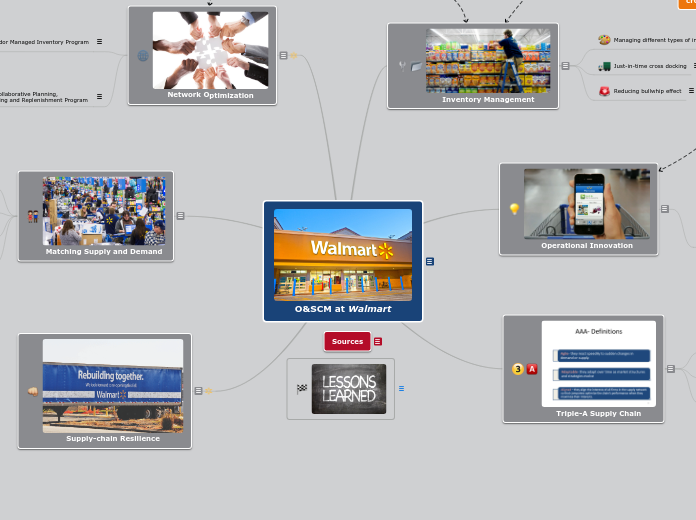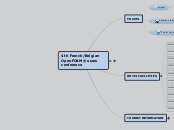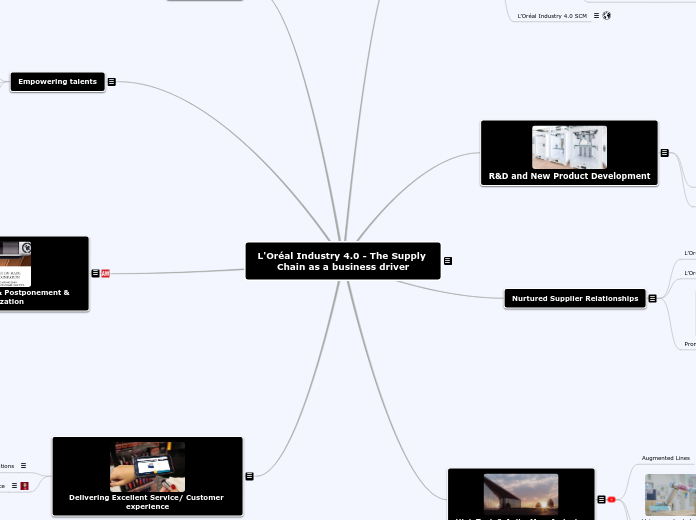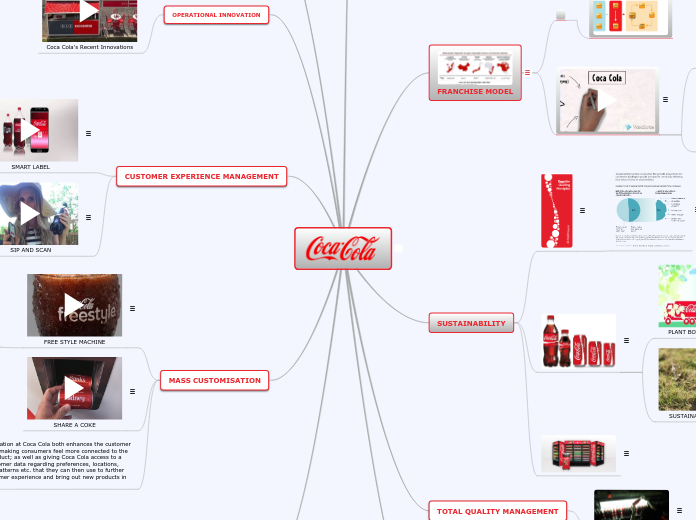When Operational Innovation and Inventory Management cross their paths...
Customer Satisfaction
"When you’re getting ready to head to Walmart, you expect everything on your list will be ready and waiting on our shelves"
Cristy Brooks - Sr. Director, Innovations Development, Walmart U.S.
Simply put, smarter inventory and network optimization make for higher customer satifaction. This is arguably the common thread behind all the elements of the Mind-Map: delivering an oustanding service to retain existing shoppers, attract new visitors and turn them into loyal and returning customers.
Sources
- https://thebusinessclass.com.mx/wp-content/uploads/shutterstock_353631137-e1537846925710.jpg
- https://www.researchgate.net/publication/320239187_Wal-Mart's_Successfully_Integrated_Supply_Chain_and_the_Necessity_of_Establishing_the_Triple-A_supply_Chain_in_the_21st_century
- https://sites.google.com/site/lmseyad11/home/4-integration-issues/4-3-triple-a-analysis-on-walmart-supply-chain
- https://blog.walmart.com/business/20170816/why-smarter-inventory-means-better-customer-service
- https://www.krunchbox.com/how-walmart-collaborates-with-its-vendors
- https://blog.8thandwalton.com/2013/05/walmart-supplier-glossary-cpfr/
- https://www.slideshare.net/DanishAliSyed1/collaborative-planning-forecasting-replenishment-at-walmart
- https://corporate.walmart.com/suppliers/supplier-inclusion
- https://www.cbsnews.com/news/the-triple-a-supply-chain/
- https://blog.walmart.com/innovation/20180201/take-a-trip-through-50-years-of-retail-innovation
- https://www.tradegecko.com/blog/incredibly-successful-supply-chain-management-walmart
- https://www.academia.edu/9437177/How_Walmart_Enhances_Supply_Chain_Management_With_CPFR_Initiatives
- https://www.tradegecko.com/learning-center/what-is-vendor-managed-inventory
- https://www.nhh.no/en/research-centres/food/food-news/2018/may/half-of-walmarts-workforce-are-parttime-workers/
- https://news.walmart.com/2018/10/30/walmart-brightens-customer-experience-and-expands-assortment-to-help-customers-light-up-christmas
- https://www.walmart.com/cp/walmart-mobile-app/1087865
- https://www.supplychaindigital.com/scm/walmart-recognised-best-supply-chain-mangement
O&SCM at Walmart
IE Business School
Master in Management - September 2018 intake
Operations Management - Prof. Felipe Quintana
Section 3
Alessandro Baratta
O&SCM at Walmart
"I don’t believe there is a university in the world that doesn’t talk about Walmart and the supply chain, they are just so well respected because they do it so well”
James Crowell - Director of the Supply Chain Management Research Center at the Walton College of Business.
Walmart, the American giant retail corporation, is the world's largest company by revenue (over $500 billion according to Fortune), as well as the largest private employer in the world (with nearly 2.3 employees); but, most importantly, it is unanimously considered a champion in supply chain management and operations. Why ? Let's find out together !
Supply-chain Resilience
"Resilience: the capacity to prepare for disruptions, recover from shocks and stresses, and adapt and grow from a disruptive experience"
The Resilience Dividend: Being Strong in a World Where Things Go Wrong, by Judith Rodin.
In the link provided, check out how Walmart successfully minimized the impact of a disruptive event (resistance), restored the situation to its pre-disruption status (recovery), and made the most out of such an intense experience to further reinforce disaster preparedness and emotional bond with its customers.
Matching Supply and Demand
When it comes to managing demand and supply, Walmart relies on several tools that we analyzed in class, and all of them have a direct influence on the supply aspects of capacity planning. The most relevant are...
Maximising Efficiency
Does it really require further explanation ?
Increasing Customer Participation
Systems like Walmart Scan & Go and, more recently, all the services integrated into the Walmart Mobile App are examples of ways to enhance consumer participation. The rationale is quite straightforward: the more the consumer does, the lower the labor requirements of the company.
Standardization
The company heavily relies on standardized procedures (that ultimately turn into routines) at different stages of its supply chain and operations.
50% Part Time employees
Part-time workers account for half of Walmart’s workforce, up from 20 percent in 2005, according to Reuters.
Network Optimization
Closely related to inventory management, network optimization represents a second key enabler of Walmart's success, as the company has historically aimed at integrating its strategic suppliers into its supply chain dynamics. In this respect, how can supplier participation further expand the effectiveness of Walmart's supply chain and inventory management?
+ A solid and diverse network of suppliers has always been an important asset to the company. To get a grasp of this, check out the CEO message concerning the mutual benefits of promoting diversity across supply chain - linked attached !
CPFR: Collaborative Planning, Forecasting and Replenishment Program
In the 20th century, Walmart and Procter & Gamble developed a joint logistics program that included information sharing, joint logistics planning, shared forecasting, and replenishment program. This is generally considered one of the the first examples of organized CPFR. Still today, this cooperation enables Walmart to maintain the inventory in retail outlets and establish a reordering system that links all computers of P&G to Walmart’s stores and warehouses. P&G will receive a message from the computer system whenever this system identifies certain merchandise needed to be replenished, and then a replenishment order will be sent to the nearest P&G through this system before delivering products to distribution centre or to stores.
Some of the elements of CPFR include POS data, retail analytics, logistics systems, demand driven production planning, shared responsibility for replenishment, and warehousing.
VMI: Vendor Managed Inventory Program
Walmart’s success in managing its inventory is partly due to the effective implementation of the vendor-managed inventory model. In this model, suppliers access data from the company’s information systems, such as data on current inventory levels and the rate at which certain goods are sold. Suppliers decide when to send additional goods to Walmart, while the company monitors and controls the actual transit of goods from warehouses to the stores. This strategy shifts some of the inventory control activities onto the side of the suppliers. Walmart’s vendor-managed inventory has the benefit of minimizing delays in the movement of inventory across the supply chain. Another beneficial effect of using the vendor-managed inventory model is the minimization of costs in inventory management activity. The company does not need to spend for extra personnel to manage each supplier’s goods. Instead, this financial and human resource expense is directly passed on to Walmart’s suppliers.
VMI a while ago (warning: explicit vintage content)
Triple-A Supply Chain
At Walmart, the Triple-A Supply Chain model is an overarching paradigm, since it encompasses all the different topics we have seen so far ...
Alignment
Alignment - Walmart’s supply chain fulfils the criteria of alignment, as clearly shown by its strong network integration. In this respect, the strategic alliance between Walmart and Procter and Gamble is a valid example, as the two giants concurrently maximise their mutual interests and optimize the supply chain performance.
Adaptability
Adaptable - The relentless pursuit of new ways of doing work highlights the capacity of the company to evolve over time as economic progress, political shifts, demographic trends, and technological advances reshape markets.
Agility
Agility - In facing hurricane Katrina, the company evidently demonstrated its ability to respond quickly to abrupt changes in demand, to handle unexpected external disruptions smoothly and cost-efficiently, and to recover promptly from them.
Operational Innovation
"To succeed in this world, you have to change all the time"
Sam Walton - Founder of Walmart.
From pioneering the first large discount stores, to being the first to use universal product codes (the bar codes on virtually every product you buy today), to adding innovative e-commerce retailers to the family, Walmart is always looking ahead for ways to deliver even more value for its customers.
Check out the video to learn how the evolution of Walmart has driven change in retail over the years !
A Trip Through 50 Years of Walmart’s Retail Innovation
Inventory Management
Walmart’s inventory management is a key factor to the success of the multinational retail business. Considering the mammoth size of the company, effective and efficient inventory management is paramount in operational effectiveness. What are indeed the most significant aspects of inventory management at the US giant ?
Reducing bullwhip effect
As seen in class, the bullwhip effect refers to the phenomenon of demand variability amplification as moving up in the supply chain, from the point of actual (final) demand to the point of origin. This implies that even a small inaccuracy in one part of Walmart’s supply chain could lead to bigger errors and higher costs across the supply chain. The company minimizes the bullwhip effect in its supply chain through an advanced inventory information system whose data are directly accessible by Walmart's strategic suppliers (we will dive into this topic in a couple of clics!). By doing so, the company’s personnel have minimal contribution to possible errors in managing the movement of goods from the suppliers to the company’s stores.
Just-in-time cross docking
Just-in-time inventory is the application of the just-in-time (JIT) method to inventory management, and it aims at minimizing storage and related costs. At Walmart, the just-in-time inventory method is applied in the form of cross-docking. In cross-docking, suppliers’ trucks and the company’s trucks meet at the company’s warehouses or merchandise distribution centers. Goods are transferred from the suppliers’ trucks directly to Walmart’s trucks, which deliver the goods to the stores. The main benefit of cross-docking at Walmart’s warehouses is the minimization of inventory size, as fewer goods are stored at the warehouses. Also, cross-docking enables Walmart to quickly deliver goods to the stores. This condition enables the firm to rapidly respond to fluctuations in demand and related changes in the market. Thus, this method of inventory management supports Walmart’s operational efficiency and business resilience.
Managing different types of inventory
Walmart relies on many types of inventory (most of them appears also in the "Managing Inventories: Fundamentals" technical note!), each with a corresponding set of management approaches, strategies, and tactics. The most relevant types include:
Finished goods inventory - the most significant in Walmart’s business, its role is to support Walmart store operations.
Transit inventory - this type of inventory refers to the goods that are held while in transit. Its role is to support the replenishment of the finished goods inventory in the merchandise distribution centers and Walmart stores.
Buffer inventory - Walmart uses the buffer inventory type in its stores by keeping a small margin of extra goods in order to maintain business continuity when demand suddenly fluctuates.
Anticipation inventory - Walmart uses the anticipation inventory type to ensure optimal capacity to satisfy consumer demand. Unlike the buffer inventory, the anticipation inventory type is based on seasonal changes and corresponding empirical data on seasonal changes in the market.









